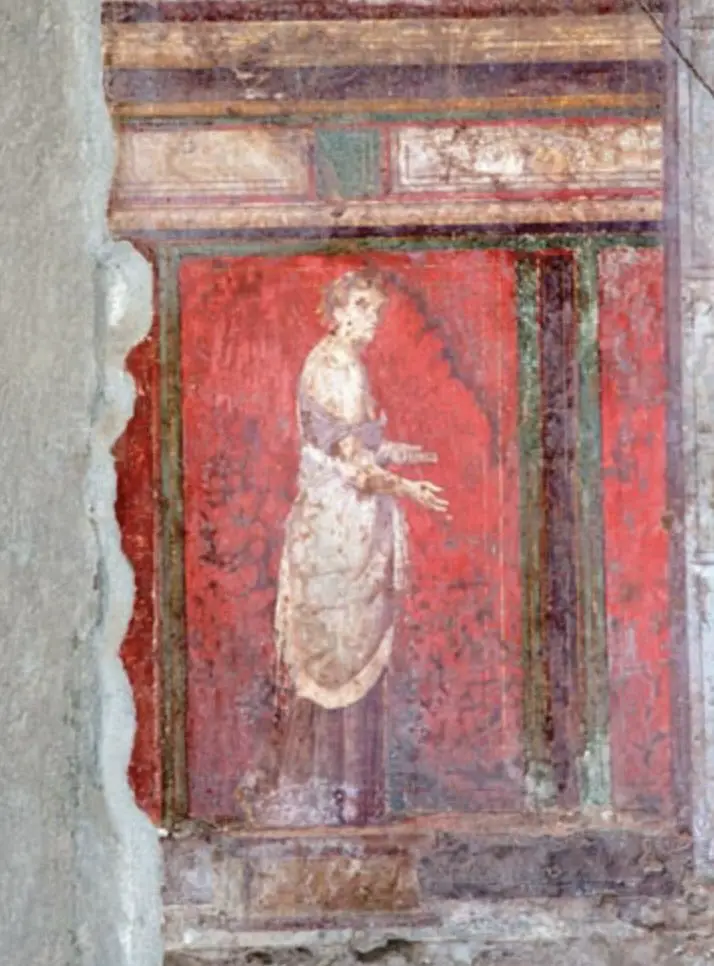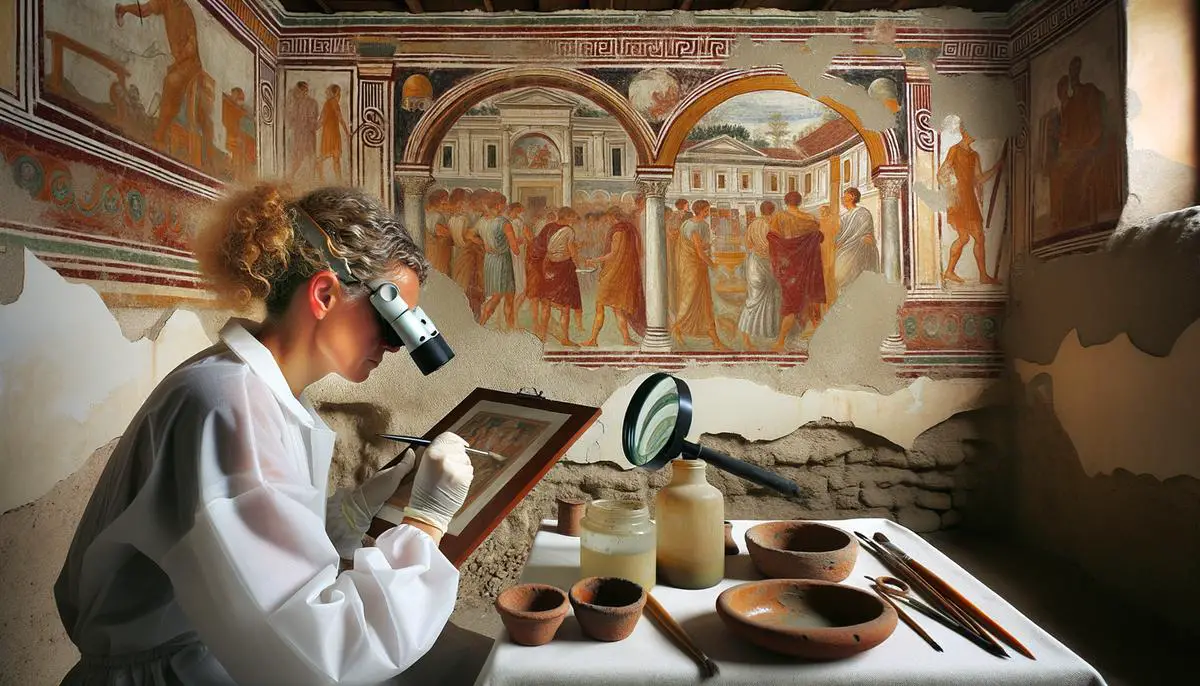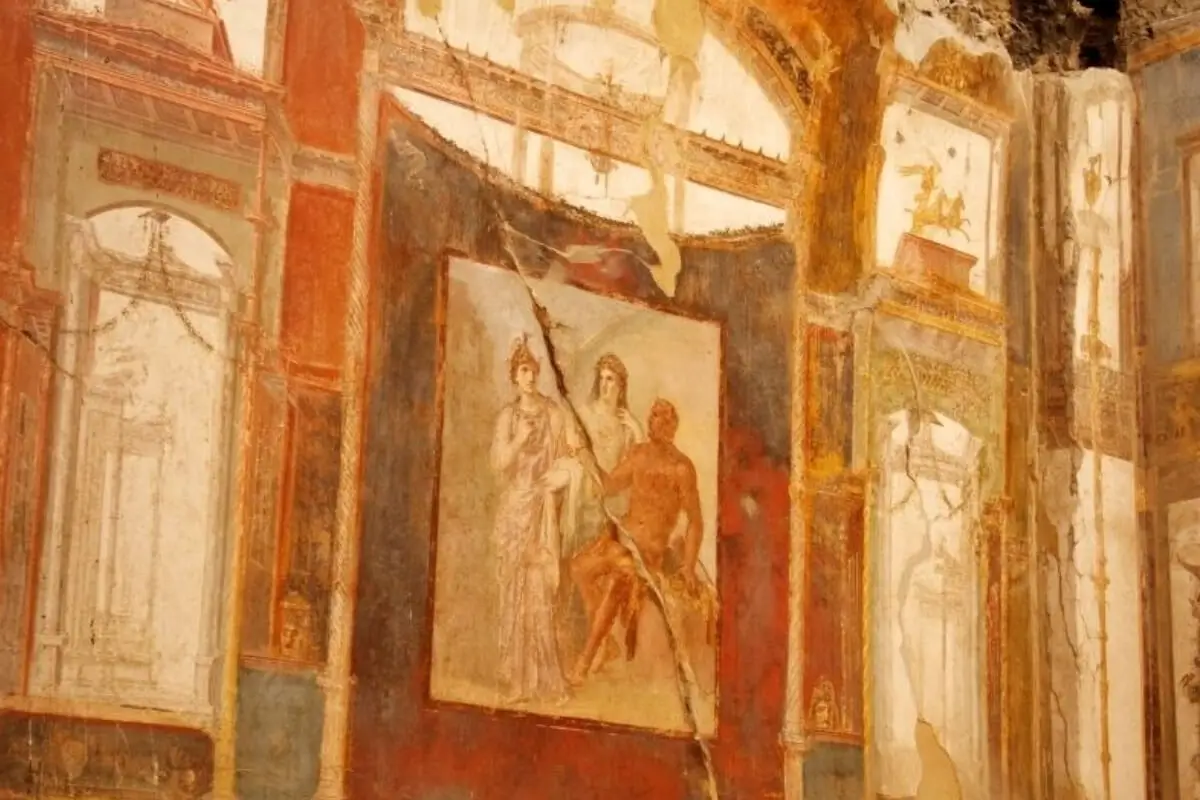Roman frescoes offer a unique glimpse into an era that continues to influence our present, bridging ancient Roman society and modern-day cultures. These artworks highlight the Romans’ artistic mastery and shed light on their daily lives, beliefs, and the natural world around them.
As we explore Roman fresco art’s distinctive techniques, materials, and themes, we understand how these creations were more than just decorations; they were an integral part of Roman identity and legacy.
Table of Contents
- Historical Context of Roman Fresco
- Techniques and Materials
- Iconography and Themes
- Preservation and Restoration Challenges
- Related Questions
Historical Context of Roman Fresco
In the grand spectacle of Roman history, frescoes stand out as more than just artwork; they were an essential part of both public and private life, reflecting the soul of Roman culture and its enduring legacy. The journey of frescoes from mere wall coverings to an emblem of Roman sophistication and expression is a testament to the evolution of this art form and its integration into daily existence.
The inception of frescoes in Roman society can be traced back to the Greeks, whose artistic traditions the Romans admired and adopted. However, what started as an emulation quickly transformed into innovation as Romans began to carve out their identity in frescoes.
These mural paintings, created by applying pigment to wet plaster so that the color would become an integral part of the wall, were not just decorative. They were narrative tools, capturing everything from everyday life scenes to mythological stories, thus serving as historical documents and reflections of personal taste and social status.
Frescoes were omnipresent in Roman life, adorning the walls of lavish villas, public buildings, and sacred spaces. The affluent saw an opportunity to display their wealth, education, and sophistication in frescoes. They could give their guests an image of refinement and cultural prowess through detailed depictions of feasts, landscapes, and gods. Meanwhile, frescoes in public buildings and temples were vehicles for civic pride and religious devotion, often illustrating scenes of Roman achievements and divine blessings.
The technological advancements of the Roman era lent themselves wonderfully to the spread and perfection of fresco art. Innovations in architecture, like the development of the true arch and improvements in construction materials, provided more expansive and durable canvases for artists. The Domus (Roman house), with its open floor plan centered around the atrium and peristyle, offered prime real estate for fresco decoration, making art a daily companion of the Roman household.
However, perhaps the most striking aspect of Roman frescoes is their vibrancy and realism. Thanks to the meticulous technique of the fresco process, which required a harmony between the artist’s speed and the chemical reactions of the plaster drying, the colors have remained vivid even after thousands of years. Scenes from Pompeii and Herculaneum give us a glimpse into a world where art indeed imitated life, with such accuracy and attention to detail that they serve as windows into the past, revealing the minutiae of Roman attire, architecture, and even food.
In summary, frescoes were not just art but a fundamental component of Roman identity. From their Greek-inspired beginnings to the heights of narrative and visual sophistication, they mirrored Roman society’s ambitions, innovations, and daily experiences. Through frescoes, we see the ancient Romans not as distant historical figures but as a vibrant community deeply invested in portraying and preserving their collective story.

Techniques and Materials
Venturing into the nuanced world of Roman fresco techniques and materials, peeling back the layers of history and artistry that set these ancient masterpieces apart is crucial. Roman artists’ genius wasn’t just their creativity and innovative approach to materials and methodologies. Unlike the fleeting impressions of painted canvases, Roman frescoes were built to last, etching vibrancy into the very walls of history.
Key to the Roman fresco technique was the meticulous application of wet plaster, a method known as “true fresco” or “buon fresco.” This process involved the careful layering of plaster, usually in two phases. The initial, rough layer, known as the “arriccio,” prepared the wall for the final, smooth coat called the “intonaco.” It was on this freshly laid intonaco that artists had to work swiftly, painting with pigments mixed solely with water. As the plaster dried, a chemical reaction occurred, binding the pigments to the wall and ensuring the longevity and vibrancy of the colors. This chemistry behind the scenes breathed life into Roman frescoes, allowing them to withstand the test of time.
The spectrum of colors in Roman frescoes spoke volumes of their mastery over materials. Pigments were derived from natural minerals and earth and had symbolic and aesthetic value. The iconic Pompeian red, for instance, came from cinnabar or hematite, commanding attention and exuding luxury.
Egyptian blue, another staple, showcased their trade connections and chemical know-how. It was one of the first synthetic pigments produced by heating together silica, lime, copper, and alkaline salts. These colors were chosen not just for their aesthetic appeal but also for their durability under the fresco technique’s demanding conditions.
Beyond colors and application, Roman frescoes set themselves apart by mastering illusionistic effects. Artists employed techniques like foreshortening to create depth and perspective, transforming flat walls into dynamic vistas that opened up interior spaces. This play of perspective was not merely decorative. It reflected the Roman appetite for architectural grandeur and their deep appreciation for spatial dynamics, blending art and architecture into a cohesive whole.
The Roman initiative in integrating innovative materials, such as volcanic ash from regions like Pozzuoli, into their plaster underscored their architectural acumen. This addition enhanced the durability of their frescoes and revolutionized construction techniques, evidenced by the enduring legacy of structures like the Pantheon.
Furthermore, their approach was not static. Across the expansive Roman Empire, fresco artists adapted and evolved their techniques, incorporating local styles and materials. This adaptability speaks volumes of a culture that, at its core, was expansive and inclusive, absorbing influences and refining them into something quintessentially Roman.
Roman frescoes’ distinction lies in their visual splendor and the confluence of art, science, and architecture they represent. Through their innovative use of materials and techniques, Roman frescoes etched narratives not just on walls but into the fabric of history, leaving a legacy that continues to captivate and educate.

Iconography and Themes
A rich tapestry of recurring themes and imagery unfurls in Roman frescoes, painting a vibrant panorama of ancient Roman life and beliefs. At the core of Roman fresco iconography are depictions of mythology, nature, everyday life, and the afterlife, each intertwining with the others to create a multifaceted visual language that spoke volumes about the world from which it stemmed.
Mythology was prominent in Roman frescoes, serving as a bridge between the divine and the mortal. The gods and goddesses of Roman lore were not just figments of imagination. Still, they were integrated into the daily lives of the Romans, influencing everything from seasons and harvests to love and war.
Frescoes often depicted scenes from myths, such as the trials of Hercules or the adventures of Dionysus, offering decoration, a connection to the divine, and an expression of personal piety and cultural identity. These mythological narratives were more than mere stories; they were imbued with symbolic meanings, illustrating virtues, vices, and the eternal struggle between good and evil.
In its unbridled glory and tranquil beauty, nature is another recurring theme in Roman frescoes. Gardens, landscapes, and detailed depictions of flora and fauna adorned the walls of Roman homes, creating a sense of perpetual spring and bringing the outdoors in. These verdant scenes were not purely ornamental; they reflected the Roman appreciation for nature’s beauty and fertility, symbolizing prosperity and harmony.
In villas and public buildings, frescoes of plants, animals, and idyllic landscapes brightened spaces and conveyed the owner’s taste, wealth, and philosophical leanings toward the natural world.
Everyday life, with its routines and rituals, found a vivid canvas in Roman frescoes. Scenes of banquets, domestic activities, sports, and other daily pursuits were commonplace, offering a window into the private lives of Romans across the social spectrum.
These images were more than just snapshots of daily life; they celebrated the Roman way of life, showcasing the elegance, sophistication, and sometimes decadence that characterized the upper echelons of Roman society. Through these depictions, frescoes told stories of leisure and labor, of public and private realms, providing insight into the social roles, relationships, and values that defined Roman culture.
The afterlife, a realm shrouded in mystery and ripe with curiosity, also found expression in Roman frescoes. Imagery of the soul’s journey, divine judgment, and the underworld reflected the Roman conceptions of death and the hereafter. These frescoes served as a reminder of mortality and a means of ensuring a favorable passage to the afterlife. By depicting scenes of the afterlife, Roman frescoes fulfilled a dual role as artistic expressions and vehicles for religious and funerary practices, weaving the sacred and the mundane into a coherent visual narrative.
These themes – mythology, nature, everyday life, and the afterlife – are not isolated motifs but rather interrelated strands that, when woven together, form a comprehensive picture of Roman life and ideology. Through their frescoes, the Romans left a rich visual legacy that continues to captivate and educate, offering an enduring testament to their artistic prowess, cultural values, and philosophical depth.

Preservation and Restoration Challenges
Today’s conservators are tasked with preserving ancient Roman frescoes, intricate artworks that have survived centuries. These professionals grapple with various challenges to ensure future generations can appreciate this window into the Roman world.
One of the primary hurdles is environmental degradation. Over time, factors like moisture, temperature fluctuations, and pollution have contributed to the deterioration of frescoes. For instance, moisture can seep into the plaster layers, leading to mold growth or the formation of salts that can cause the paint to flake off. Similarly, constant changes in temperature can lead to the expansion and contraction of materials, further damaging these ancient artworks. Controlling the environment around these frescoes can be costly and technically challenging.
Another issue is previous restoration efforts. Throughout history, various attempts have been made to restore these frescoes, some of which have inadvertently caused more harm than good. For example, it was common to use heavy varnishes to “protect” the paintings in the past. Over time, however, these substances can turn yellow or even crack, obscuring the original artwork. Removing these layers without damaging the fresco underneath requires a delicate touch and an advanced understanding of chemistry and art history.
Furthermore, Roman frescoes’ original techniques and materials pose their unique challenges. The “true fresco” technique, which involves applying pigment to wet plaster, creates a durable color bond. However, this exceptional durability makes it challenging to perform any restoration work without risking the integrity of the original artwork. Matching the ancient pigments, made from natural minerals, is also no small feat, as many of these materials are no longer available or are protected, making replication difficult.
Conservators must also wrestle with ethical considerations and the philosophy of preservation. Determining how much intervention is too much or deciding whether to restore a fresco to its original state or to preserve it as it is found involves complex decision-making. These decisions must balance respecting the original artwork’s integrity with making it understandable and relatable for modern audiences.
To tackle these challenges, modern conservators employ a mix of traditional techniques and cutting-edge technology. Digital imaging and 3D printing can help analyze damage and plan restorations, while microscopic analysis can identify original pigments and materials. Despite these advances, conservators often act as much as detectives as they are artists or scientists, piecing together clues to bring these ancient artworks back to life.
Therefore, working with ancient Roman frescoes is about preserving art pieces and maintaining a tangible connection to the past. Each challenge conservators overcome allows us to step directly into the world of ancient Rome, offering insights into a civilization that has shaped our own. However, with each passing year, these challenges only grow more complex, reminding us of the delicate balance between preservation and decay.

As we delve into the complex world of preserving Roman frescoes, we are reminded of the delicate thread that connects us to the ancient past. We see the dedication to keeping history alive through each challenge that conservators face, from environmental degradation to ethical dilemmas.
These frescoes are not just static images on a wall; they are vibrant storytellers who continue to speak to us, offering insights and reflections on a civilization whose impact is seen and felt today. By preserving them, we honor Roman art, culture, and the enduring human spirit of creativity and innovation.
Anita Louise Art is dedicated to art education, great artists, and inspiring others to find and create their art. We love art that uplifts and inspires. #ArtToMakeYouSmile! #ArtToMakeYouHappy!
If you are interested to see any of my art, you can find out more by clicking here. If you are interested in what inspires me and my paintings, you can discover more by clicking here.
We have a free newsletter and would love you to be part of our community; you can subscribe to the newsletter by clicking here. If you have any questions, I would be happy to talk to you at any time. You can reach me, Anita, by clicking here.
Subscribe to our Anita Louise Art YouTube Channel filled with great videos and information by clicking here.
Join us for our podcast “5 Minutes With Art.” Spend just 5 minutes a week with us to discover and learn about great art and artists. You can find out more about our podcast by clicking here.
Related Questions
Why Did New Art Movements Develop In The Years Following World War 1?
Many of the art movements after World War 1 came about as a direct protest about the devastation and loss of human life in the First World War. These art movements also included cultural and political movements where like-minded artists band together to produce satirical and other art.
By clicking here, you can learn more by reading Why Did New Art Movements Develop In The Years Following World War 1?.
What Are The Main Characteristics Of Minimalism Art?
Minimalism art started in New York City in the 1960s. The minimalist artist would use limit their use of lines, shapes, and colors in their art. The artwork had no trace of the artist’s emotions in the art. Minimalism art is considered an extreme form of abstract art. The most important geometric shapes in minimalism art are the square and rectangle.
You can discover more by reading What Are The Main Characteristics Of Minimalism Art? by clicking here.
How Do Art Movements Begin?
An art movement usually begins as a specific philosophy, goal, or objective that a group of typical artists have. This could include a standard belief system or a belief in a common style of art. An art movement usually changes the artistic direction of the artwork for its time.
You can learn more by reading How Do Art Movements Begin? by clicking here.

